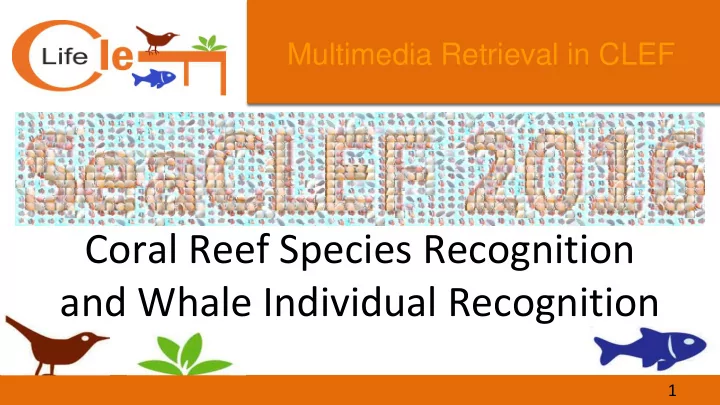

Multimedia Retrieval in CLEF Coral Reef Species Recognition and Whale Individual Recognition 09/09/2015 09/09/2015 1 1 1
Context and challenges • Exponential growth of sea-related multimedia data in the forms of images/videos/sounds – Fish biodiversity monitoring – Marine resource sustainability – Fishery – Educational purposes • Analysis of such data is very time-consuming for human operators 09/09/2015 09/09/2015 2 2 2
Objectives • Develop automated multimedia analysis methods for making sense of massive sea-related data collected by either human operators (volunteers) or imaging devices 09/09/2015 09/09/2015 3 3 3
Tasks SeaCLEF 2016 features two tasks: • Coral Reef Species Recognition : video-based identification of fish species. • Whale Individual Recognition : image-based matching of caudals of same individual whales. 09/09/2015 09/09/2015 4 4 4
Coral Fish Species Recognition: Task description The goal is to analyze underwater videos and identify coral reef fish and recognize their species. Correctness metric is per-species individual count. 09/09/2015 09/09/2015 5 5 5
Coral Fish Species Recognition: Dataset • 700,000 10-minute underwater videos (about 250 TB) recorded from Taiwan’s coral reefs • One of the largest biodiversities in the world: 3,000 fish species – http://shdb.sinica.edu.tw 09/09/2015 09/09/2015 6 6 6
Coral Fish Species Recognition: Training set • 20 manually-annotated videos with bounding boxes and species names – More than 9,000 bounding box + species annotations • 15 fish species – For each species, a set of sample images is provided (20,000 in total) – fishbase.org links, with information and additional images, are provided. 09/09/2015 09/09/2015 7 7 7
Coral Fish Species Recognition: Training set • Unbalanced dataset – 3165 instances of Dascyllus reticulatus – 72 instances of Zebrasoma scopas • Annotation performed on a single-frame basis – Tracking is out of the scope of the task – Temporal consistency was not exploited by annotators 09/09/2015 09/09/2015 8 8 8
Coral Fish Species Recognition: Training set XML Annotation format: 09/09/2015 09/09/2015 9 9 9
Coral Fish Species Recognition: Training set Fish species distribution in training set: 09/09/2015 09/09/2015 10 10 10
Coral Fish Species Recognition: Test set • 73 manually-annotated videos 09/09/2015 09/09/2015 11 11 11
Coral Fish Species Recognition: Run submission • Participants can submit up to three runs • Each run submission is an XML file in the same format as the training ground-truth • Fish with species not present in training set should be labeled as “Unknown” 09/09/2015 09/09/2015 12 12 12
Coral Fish Species Recognition: Metrics Counting score: • Computed per species • d is the difference between counted fish in the submission and ground truth count • Does not take into account bounding-box matching correctness 09/09/2015 09/09/2015 13 13 13
Coral Fish Species Recognition: Metrics Precision: • Computed per species • Bounding box match if “intersection over union” greater than 0.3. • Shows accuracy in identifying the correct species of each bounding box 09/09/2015 09/09/2015 14 14 14
Coral Fish Species Recognition: Metrics Normalized counting score: • Combines counting accuracy with bounding box matching accuracy Final submission score is computed by averaging NCS over all species. 09/09/2015 09/09/2015 15 15 15
Coral Fish Species Recognition: Participants Teams: • CVG_Jena_Fulda • Bmetmit 09/09/2015 09/09/2015 16 16 16
Coral Fish Species Recognition: Results 09/09/2015 09/09/2015 17 17 17
SeaCLEF: whales Concetto Spampinatto, univ. of Catania Julien Champ, Inria Simone Palazzo, univ. of Catania Context: CetaMada NGO • Whale’s watchers volunteers • Madagascar area • Manual photo-identification thanks to biomarkers Objective: given thousands of whale’s caudal pictures, find the ones belonging to a same individual ( photo-identification ) • Unsupervised identification (no training data to recognize each of the 1000 ’s of individuals) • Thanks to biomarkers (spots, scars, etc.) 13/11/2015 13/11/2015 18 18 18
SeaCLEF: whales Spot the difference game ! Good matches (very few) Bad matches (a lot !) 13/11/2015 13/11/2015 19 19 19
SeaCLEF: whales Concetto Spampinatto, Univ. of Catania Julien Champ, Inria Simone Palazzo, Univ. of Catania - The use of rigid epipolar geometry allows rejecting false alarms - Hash-based indexing allows breaking the quadratic complexity 13/11/2015 13/11/2015 20 20 20
Conclusions and future directions • Effective approaches for both video-based fish counting system and whale individual identification • Low participation due to the high complexity of the tasks, which mainly pertain computer vision (loosely related to multimedia) • Extend past editions by: – Increasing the tackled marine organisms species (from fish to salmon to whales to seabeds, etc.) – Enriching the visual data modalities (not only 2D images, but also thermal and stereo images as well as audios) for supporting the analysis, thus making them proper multimedia analysis tasks. 09/09/2015 09/09/2015 21 21 21
Recommend
More recommend